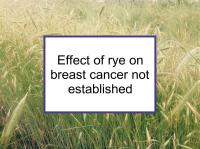Rye (Secale cereale) is a good source of enterolactone, fiber and manganese. Rye also incorporates some ferulic acid, which has chemopreventive properties with respect to breast cancer. High whole rye intake has been found to have cardioprotective effects and has been linked to lower risk of colon cancer, although not all studies are in agreement.
Breast cancer-related effects of eating rye
Rye is a good source of both enterolactone and dietary fiber, both of which have been linked to reduced risk of breast cancer and its recurrence.
Enterolactone
Enterolactone is a phytoestrogen produced by intestinal microflora in the upper part of the colon from the lignan secoisolariciresinol diglucoside (SDG) in rye. Supplementation with SDG significantly reduced tumor weight in a mouse model of breast cancer in one study.
Enterolactone has been found to suppress proliferation, migration and invasion of triple negative (ER-/PR-/HER2-) breast cancer cells. One large U.S. study found that urinary enterolactone was inversely associated with C-reactive protein (CRP), a marker of inflammation. Another study reported that high circulating levels of enterolactone reduced the risk of breast cancer recurrence and death among postmenopausal women, especially those with estrogen receptor negative (ER-) breast cancer.
Enterolactone has also been found to increase the sensitivity of breast cancer cells to radiation, thereby potentially enhancing the treatment effects of radiotherapy.
Dietary fiber
Whole rye is a good source of both soluble and insoluble fiber. Soluble fiber dissolves in water and forms a gel, which slows digestion. Insoluble fibers do not dissolve in water; they add bulk to the diet and speed up the passage of food and waste. High intake of dietary fiber is associated with reduced risk of breast cancer. Please see the fiber webpage.
Population studies
Several Scandinavian studies have reported either no clear relationship between breast cancer risk and intake of whole rye products or that women with high rye bread intake actually have a higher risk of breast cancer. It is not clear whether this due to the effects of rye itself or of the butter, cheese and processed meats that Scandinavians typically consume with rye bread. This finding is the reason we have not categorized rye as recommended for breast cancer patients and survivors.
Additional comments
Celiac disease is an autoimmune disease triggered by the ingestion of gluten, which is contained in rye. Although, generally speaking, celiac disease increases cancer risk, several studies have shown a lower risk of breast cancer in patients affected by celiac disease.
Scandinavian crispbread traditionally is made from whole rye, although crispbreads made from other grains are available in the U.S. Refined rye flour and products made primarily from refined rye flour contain considerably fewer of the presumed anticarcinogenic substances found in whole rye products.
Although uncommon today, human poisoning due to the consumption of rye bread made from ergot fungus-infected grain was common in Europe during the Middle Ages and later. Ergot alkaloids have neurotropic properties that may cause hallucinations, irrationality, convulsions, and death. Ergot contains ergotamine, which is used to make lysergic acid, a precursor for the synthesis of lysergic acid diethylamide (LSD). Other symptoms of ergotism include strong uterine contractions; in the past, controlled doses of ergot were used to induce abortions and to stop maternal bleeding after childbirth. Newer varieties of rye have a greater resistance to ergot and improved farm management practices have greatly reduced ergot infestation. Ergot exposure has not been linked to any increases in cancer.
Below are links to recent studies concerning this food and its components. For a more complete list of studies, please click on rye.
